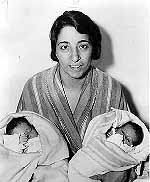 | ||||||
|
In 1944, Harvard researcher John Rock reported one of the biggest breakthroughs in fertility medicine: Rock's team fertilized four human embryos in a laboratory dish. While the embryos were never returned to the womb, this experiment was the first in vitro (Latin for "in glass") fertilization in US history. Publicity over in vitro and other technological developments sparked a surge in demand for infertility services. In 1953 Good Housekeeping magazine described infertility as a scourge that science would soon vanquish.
Childless women flooded Rock and other practitioners with letters desperate for help. But science had promised more than it could deliver -- ovarian stimulation drugs such as Clomid and Pergonal would not be widely available until the 1960s. The first American in vitro baby would not be born until 1981. Part six: Making Babies for America |


